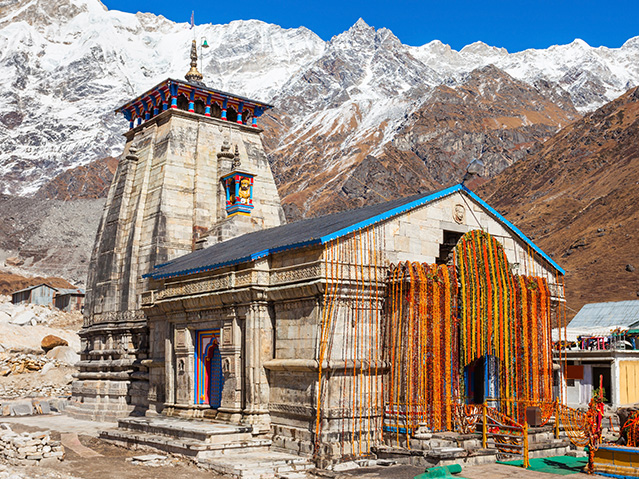Kedarnath Temple
Click the 'Play' button to read out loud this webpage content
Kedarnath Temple
Kedarnath Temple is a sacred abode of Shiva. Kedarnath pilgrimage is one of the most popular pilgrimages for Hindus annually. It is one of the 12 Jyotirlingas in the Rudraprayag district, Uttarakhand. The temple stands 3,583 meters above sea level. Kedarnath is the most renowned temple among the Panch Kedar: Kedarnath, Tungnath, Madyamaheswar, Rudranath, and Kalpeswar. These temples are in the Garhwal Himalayas. The Kedarnath Dham is also a part of the Char Dham Yatra. Kedarnath Temple lies near the milky white Mandakini River. Kedar is another name for Shiva, the presiding deity in the temple.
Legend of Kedarnath Temple

According to legend, the Pandavas built the Kedarnath Temple after the Kurukshetra war. They wanted Shiva to forgive them for their sins caused by killing their Kaurava brothers in the war. But Shiva did not wish to forgive them and hid in Gupt Kashi.
In Gupt Kashi, the Pandavas and Draupadi spotted a bull that was different from other bulls. Bheema found that the bull was none other than Shiva. They failed to catch the bull, which left its hump behind and vanished.
The Pandavas worshipped the hump, and they later built a temple. The remaining portions of Shiva in the form of a bull appeared in various places: the face (Rudranath), belly (Madyamaheswar), head (Kalpeswar), and arms (Tungnath). Kedarnath and these four sacred spots comprise the Panch Kedar.
The Architecture of Kedarnath Temple
Adi Shankaracharya built the present Kedarnath Temple in the 8th century AD. The Pandavas built the earlier temple adjacent to the present one. The Kedarnath Temple is over 1200 years old.
The temple was built using huge grey stones and showcases ancient Indian craftsmanship. Kedarnath Temple is 85 feet high, 187 feet long, and 80 feet wide. The temple's walls are 12 feet thick and made of strong stones. Its roof comprises overlapping slabs of stone, creating a dome-like structure.
The inner walls of the assembly hall feature images of other deities and scenes from mythology. The temple's exterior contains several miniature shrines dedicated to different deities.
The entrance porch (Ardha Mandap) is the outermost part of the temple and serves as a gateway to the assembly hall (Mandap). The Kedar Temple has a sanctum sanctorum (Garbha Griha), which houses the presiding deity Kedarnath Jyotirlinga. Huge stone pillars support the wide assembly hall (Mandap) which accommodates pilgrims and visitors. The Kedarnath Temple is constructed on a rectangular platform on a plinth 6 feet high using huge and heavy stone slabs. A large statue of the Nandi (divine vehicle) stands as a guard outside the temple door.
Devotees worship a conical-shaped rock inside the temple as Shiva in his Sadashiva form. It is believed to be a self-manifested form (Swayambu) of Shiva and is the highest of all 12 Jyotirlingas spread across the country.
Festivals in Kedarnath Temple
- Special Samadhi Pooja is performed on the first day of Kartik month when the Kedarnath Temple closes.
- The Badri-Kedar festival is held in June that lasts for eight days. Many popular artists from across the country come here to perform at the cultural festival.
- Shravani Annakoot Mela is held in August. Devotees attend it one day before Raksha Bandhan. They prepare food from the newly harvested paddy and offer it to the deity. On this occasion, the Shivling is adorned with wheat, rice, and other pulses and grains.
- Maha Shivaratri, Vinayak Chathurthi, Holi, and Diwali are other festivities celebrated in Kedarnath Temple during September and October.
Benefits of Worshipping at Kedarnath Temple
Kedarnath is a very important temple of Shiva. Praying to the deity is believed to fulfill desires, relieve sins and eliminate negative forces. This is an ideal place for meditation.
If you wish to have customized spiritual tours or pilgrimages arranged in India for yourself or for a group of people, please contact Brindavan Mystic Services
Email ID: [email protected] Toll free: 1800 102 9098
How to Reach Kedarnath Temple
By Road: Gaurikund Bus Stand is the nearest bus stop to the temple. It is a 16 km distance. From Gaurikund, pilgrims have to trek up to Kedarnath Temple. Helicopter services are also available from Phata, which is 50 km from Kedarnath.
By Rail: The nearest train station is Rishikesh railway station. It is at a 216 km distance.
By Air: Jolly Grand Airport, Dehradun, is the nearest airport to the temple which is a 238 km distance.
By Trekking: Pilgrims can reach the temple, which is a 17 km distance from Gaurikund. It takes about 6-8 hours.
Kedarnath Temple Timings
The Kedarnath Temple opens only six months of the year (April-November) when the sun enters the zodiac sign of Aries. The temple closes when the sun enters Scorpio.
The priests of Omkareshwar Temple, Ukhimath, decide the opening dates of Kedarnath Temple using Hindu Panchang on Maha Shivratri every year. The closing date is always on the day of Bhai Dooj after the Diwali festival.
The Kedarnath Temple remains open from 6.00 am to 3.00 pm and 5.00 pm to 7.00 pm during April-November.
Best Time to Visit Kedarnath Temple
The perfect time to pilgrimage to Kedarnath Temple is between May and October. During winter, the idols from Kedarnath and Madhyamaheshwar are brought to Ukhimath town. Devotees worship the deity there for six months.





